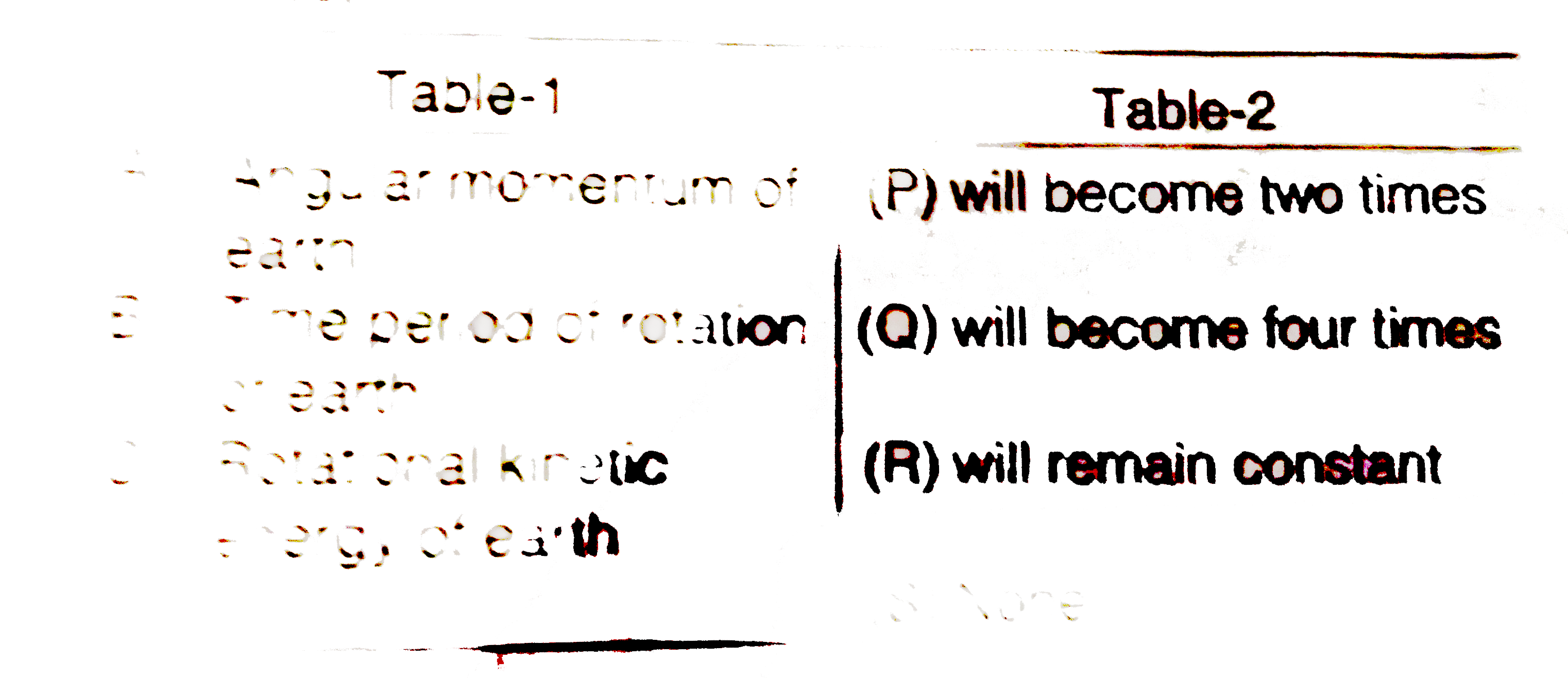Keeping the mass of the earth as constant, if its radius is reduced to 1/4th of its initial value, then the period of revolution of the earth about its own axis and passing through the centre, (in hours) is (assume the earth to be a solid sphere and its initial period of rotation as 24 h)
12
3
6
1.5
The correct Answer is:A
To solve the problem, we need to analyze how the period of revolution of the Earth changes when its radius is reduced to 1/4th of its initial value while keeping its mass constant.
1. Understanding the Initial Conditions:
- The initial period of rotation of the Earth (T) is given as 24 hours.
- We denote the initial radius of the Earth as Re.
2. Using the Formula for the Period of Rotation:
- The period of rotation (T) of a solid sphere is given by the formula:
T=2π√Rg
where R is the radius and g is the acceleration due to gravity.
3. Finding the New Radius:
- If the radius is reduced to 1/4th of its initial value, the new radius R′ is:
R′=Re4
4. Calculating the New Period of Rotation:
- We can denote the new period of rotation as T′. Using the formula for the period of rotation with the new radius:
T′=2π√R′g′=2π√Re/4g′
- Since the mass of the Earth remains constant, the acceleration due to gravity g′ at the new radius can be expressed as:
g′=GM(Re/4)2=GM⋅16R2e=16g
where G is the gravitational constant and M is the mass of the Earth.
5. Substituting g′ into the New Period Formula:
- Now substituting g′ into the equation for T′:
T′=2π√Re/416g=2π√Re64g=2π⋅18√Reg=T4
- Since the initial period T=24 hours, we find:
T′=244=6 hours
Final Answer:
The new period of revolution of the Earth about its own axis, when its radius is reduced to 1/4th of its initial value, is 6 hours.
- The initial period of rotation of the Earth (T) is given as 24 hours.
- We denote the initial radius of the Earth as Re.
- The period of rotation (T) of a solid sphere is given by the formula:
T=2π√Rg
where R is the radius and g is the acceleration due to gravity.
- If the radius is reduced to 1/4th of its initial value, the new radius R′ is:
R′=Re4
- We can denote the new period of rotation as T′. Using the formula for the period of rotation with the new radius:
T′=2π√R′g′=2π√Re/4g′
- Since the mass of the Earth remains constant, the acceleration due to gravity g′ at the new radius can be expressed as:
g′=GM(Re/4)2=GM⋅16R2e=16g
where G is the gravitational constant and M is the mass of the Earth.
- Now substituting g′ into the equation for T′:
T′=2π√Re/416g=2π√Re64g=2π⋅18√Reg=T4
- Since the initial period T=24 hours, we find:
T′=244=6 hours
The new period of revolution of the Earth about its own axis, when its radius is reduced to 1/4th of its initial value, is 6 hours.
Topper's Solved these Questions
Similar Questions
If earth radius reduces to half of its present value then the time period of rotation will become:
View SolutionOn account of the earth rotating about its axis
View SolutionIf the speed of rotation of earth about its axis increases, then the weight of the body at the equator will
View SolutionIf the radius of earth shrinks to kR (k lt 1), where R is the radius of Earth, then the time period of rotation of Earth, about its axis will become
View SolutionWhat should be the period of rotation of earth so as to make any object on the equator weig half of its present value?
View SolutionThe moment of inertia of a copper disc, rotating about an axis passing through its centre and perpendicular to its plane
View SolutionRadius of gyration of a uniform circular disc about an axis passing through its centre of gravity and perpendicular to its plane is
View SolutionThe height above the surface of earth at which the gravitational filed intensity is reduced to 1% of its value on the surface of earth is
View SolutionAssertion:We always see the same face of the moon
Reason : The period of rotation of the moon about its axis and its period of revolution about the earth are equalView SolutionIf radius of earth is reduced to half without changing its mass,
 View Solution
View Solution

